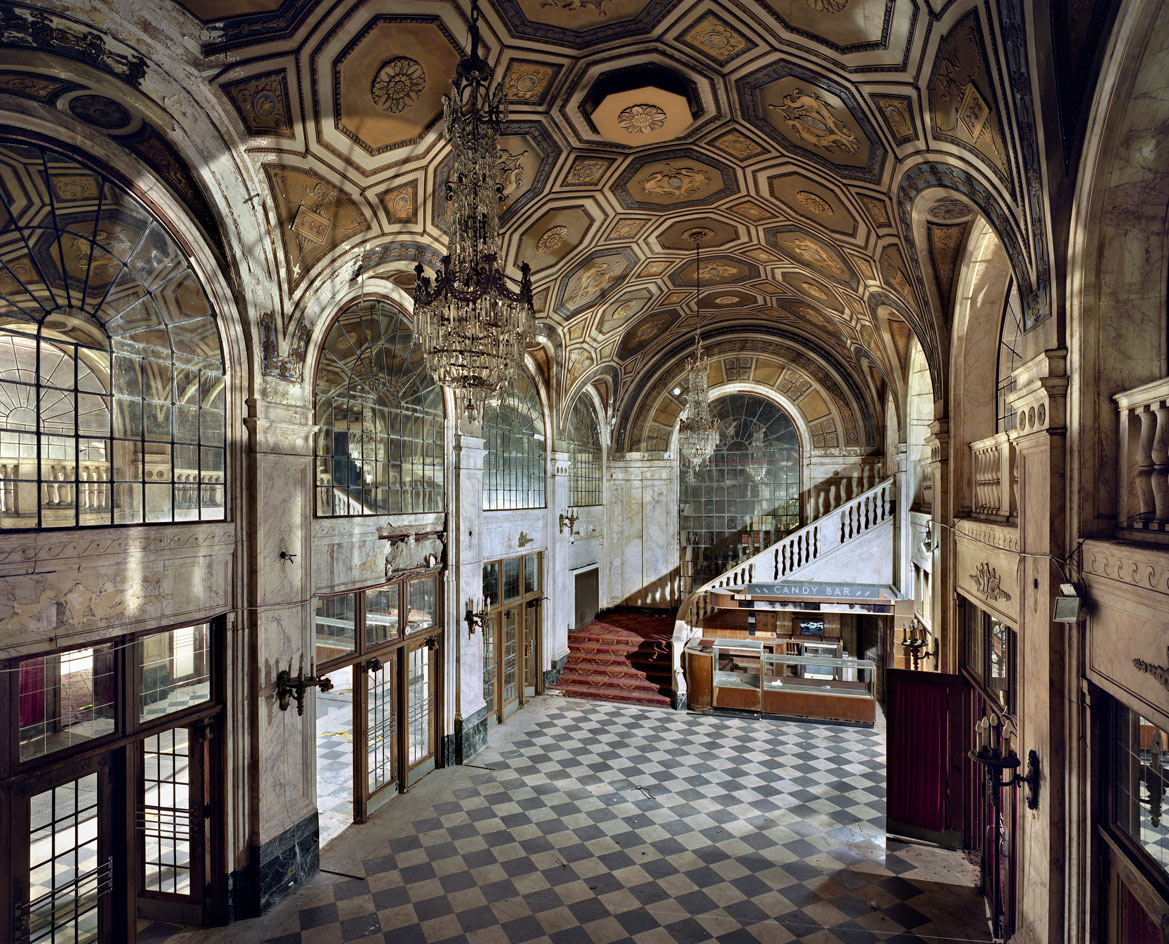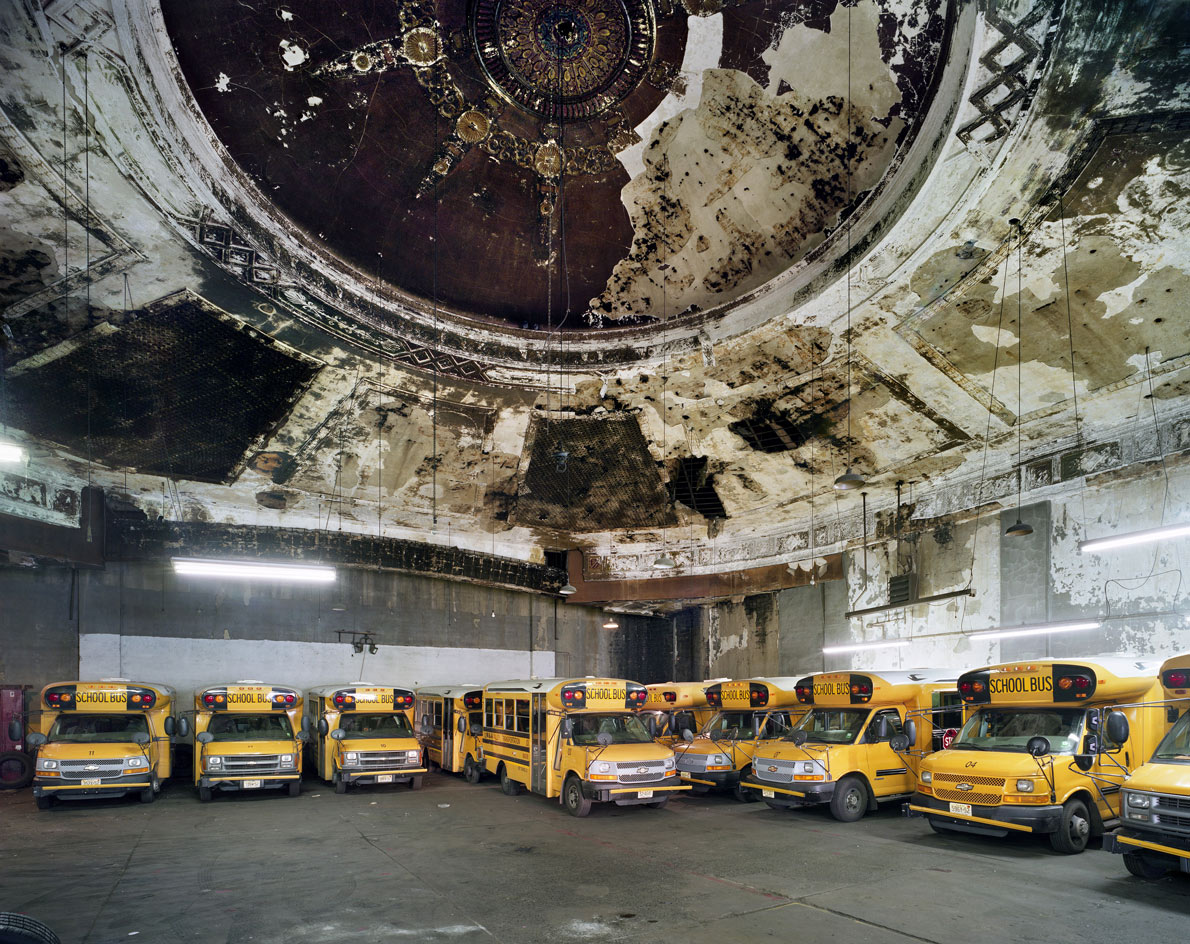Beauty and decay: inside America’s derelict movie theatres
In a new photobook, photographers Yves Marchand and Romain Meffre capture a bygone era of entertainment through decaying American movie theatres

There’s something divine about decay. Traces of what once was; eras of very different social concerns, tastes and aspirations.
Movies can give us a window into the past, and as French photography duo Yves Marchand and Romain Meffre are proving, so too can movie theatres, particularly those partially chewed up by time.

Fox Theater, Inglewood, CA.
They can still be found in many American towns; majestic shrines to film, constructed during the golden age of the entertainment. But these cinemas now stand in various states of decades-long abandonment, empty, derelict, or reborn as something else entirely. Movie Theaters, published by Prestel, is an ode to these iconic American structures, or what remains of them.
This book isn’t the duo’s first taste of tatters. They began their collaboration in 2002 by exploring Parisian remains and have published books including The Ruins of Detroit and Gunkanjima.


Top: Proctor’s Theater, Newark, NJ. Above: Paramount Theater, Newark, NJ.
The early 20th-century brought with it an entertainment boom. Hundreds of theatres popped up across the US, with many major movie studios commissioning architects to build extravagant, palatial auditoriums to satisfy the swelling appetites of spectators.
Since 2005, photographic duo Marchand and Meffre have travelled across America to visit these theatrical relics. In hundreds of lushly coloured images, they have captured the rich architectural diversity of the theatres’ exteriors and interiors, from neo-Renaissance to neo-Gothic, Art Nouveau to Bauhaus, neo-Byzantine to Jugendstil.

Columbia Theatre, Paducac, KY, 2011. Opened in 1927 and designed (1,200 seats) by Louisville-based architect W Earl Gore for Kentucky theatre operators Leo F Keiler and Rodney C Davis of Columbia Amusement and Realty Company. In the 1950s, it was modernised and partially remodelled in the Skouras style. In 1967, it was divided and a second screen was added on the balcony. It closed in 1987 and the asbestos fire curtain was renovated in 2013. It is currently awaiting renovation.

Robins Theaters, Warren, OH.
Armed with a large-format camera, they composed images spanning landscape exteriors to intimate close-ups. There’s beauty in the flaking paint, opulence in the rows of tattered crushed-velvet seats, stories retained in the defunct equipment and abandoned concession stands. Laughs, tears, screams and gasps live on in the crumbling cornices.
Receive our daily digest of inspiration, escapism and design stories from around the world direct to your inbox.
Some sites have not been left entirely for dead. But as the 1960s matured, so too did domestic TV sets and multiplexes. During the following decades, the heyday of the movie theatre was tarnished by modernisation. These majestic buildings, in turn, began taking on less majestic roles: bingo halls, basketball courts, bus depots, warehouses, fitness centres, flea markets, car parks and retail stores.
In contemporary times, where streaming services reign and convenience outshines occasion, Marchand and Meffre’s book is not just an appetising visual record of the majestic movie palace, it’s a timely eulogy for a entertainment’s golden years. Decay, in its divinity, is evidence that things have moved on, for better or worse.

State Theater, West Orange, NJ.

Meserole Theater, Brooklyn, NY.

Loew’s Kings Theatre, Brooklyn, NY, 2007. Opened in 1929, designed (3,676 seats) by architects Rapp and Rapp and Edwin C A Bullock for the Loew’s Theatres chain. It was forced to close due to poor attendances in the mid-1970s and was then independently operated from 1977 as the Kings Theatre but closed just six weeks later with Bruce Lee: The Man, The Myth. It sat vacant for more than three decades until a $93m restoration started in 2010. The Kings Theatre reopened in 2015 as a performing arts venue.

Paramount Theater, Brooklyn, NY.

Spooner Theater, Bronx, NY.

RKO Keith’s Flushing Theater, Queens, NY.

Midway Theatre, Rockford, IL, 2014. Opened in 1918, designed (1,500 seats) by architect John E O Pridmore. It was successively operated by the Ascher Brothers circuit and Balaban & Katz Corp. In 1980 a fire damaged the building, and after restoration it hosted the Rockford Symphony Orchestra, finally closing in 2006. In 2012, the roof partially collapsed. The building has since been stabilised and is awaiting renovation.

Proctor’s Theater, Troy, NY.

Meserole Theater, Brooklyn, NY.
INFORMATION
Movie Theaters, by Yves Marchand and Romain Meffre, £60, published by Prestel on 4 November 2021., prestelpublishing.penguinrandomhouse.de
Harriet Lloyd-Smith was the Arts Editor of Wallpaper*, responsible for the art pages across digital and print, including profiles, exhibition reviews, and contemporary art collaborations. She started at Wallpaper* in 2017 and has written for leading contemporary art publications, auction houses and arts charities, and lectured on review writing and art journalism. When she’s not writing about art, she’s making her own.
-
 Alexander Wessely turns the Nobel Prize ceremony into a live artwork
Alexander Wessely turns the Nobel Prize ceremony into a live artworkFor the first time, the Nobel Prize banquet has been reimagined as a live artwork. Swedish-Greek artist and scenographer Alexander Wessely speaks to Wallpaper* about creating a three-act meditation on light inside Stockholm City Hall
-
 At $31.4 million, this Lalanne hippo just smashed another world auction record at Sotheby’s
At $31.4 million, this Lalanne hippo just smashed another world auction record at Sotheby’sThe jaw-dropping price marked the highest-ever for a work by François-Xavier Lalanne – and for a work of design generally
-
 NYC’s first alcohol-free members’ club is full of spirit
NYC’s first alcohol-free members’ club is full of spiritThe Maze NYC is a design-led social hub in Flatiron, redefining how the city gathers with an alcohol-free, community-driven ethos
-
 A new photo book takes you behind the scenes of some of cinema's most beloved films, from 'Fargo' to 'Charlie's Angels'
A new photo book takes you behind the scenes of some of cinema's most beloved films, from 'Fargo' to 'Charlie's Angels'Set decorator Lauri Gaffin captures Hollywood's quieter moments in an arresting new book
-
 Sean Ono Lennon debuts music video for ‘Happy Xmas (War Is Over)’
Sean Ono Lennon debuts music video for ‘Happy Xmas (War Is Over)’The 11-minute feature, ‘War is Over!’, has launched online; watch it here and read our interview with Sean Ono Lennon, who aimed to make a music video ‘more interesting’
-
 Nadia Lee Cohen distils a distant American memory into an unflinching new photo book
Nadia Lee Cohen distils a distant American memory into an unflinching new photo book‘Holy Ohio’ documents the British photographer and filmmaker’s personal journey as she reconnects with distant family and her earliest American memories
-
 Wes Anderson at the Design Museum celebrates an obsessive attention to detail
Wes Anderson at the Design Museum celebrates an obsessive attention to detail‘Wes Anderson: The Archives’ pays tribute to the American film director’s career – expect props and puppets aplenty in this comprehensive London retrospective
-
 Ed Ruscha’s foray into chocolate is sweet, smart and very American
Ed Ruscha’s foray into chocolate is sweet, smart and very AmericanArt and chocolate combine deliciously in ‘Made in California’, a project from the artist with andSons Chocolatiers
-
 Out of office: the Wallpaper* editors’ picks of the week
Out of office: the Wallpaper* editors’ picks of the weekAs we approach Frieze, our editors have been trawling the capital's galleries. Elsewhere: a 'Wineglass' marathon, a must-see film, and a visit to a science museum
-
 Jamel Shabazz’s photographs are a love letter to Prospect Park
Jamel Shabazz’s photographs are a love letter to Prospect ParkIn a new book, ‘Prospect Park: Photographs of a Brooklyn Oasis, 1980 to 2025’, Jamel Shabazz discovers a warmer side of human nature
-
 The Hammer Museum in Los Angeles launches the seventh iteration of its highly anticipated artist biennial
The Hammer Museum in Los Angeles launches the seventh iteration of its highly anticipated artist biennialOne of the gallery's flagship exhibitions, Made in LA showcases the breadth and depth of the city's contemporary art scene